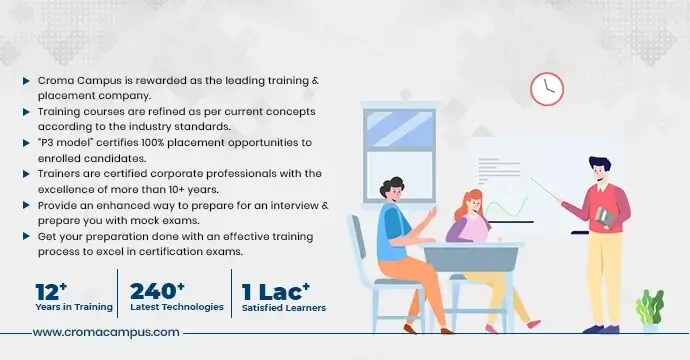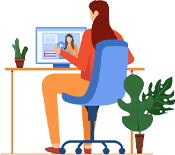Course Design By
Nasscom & Wipro
Home /Full Stack Development/ Java Full Stack Developer Course in Pune
Build full stack applications using Java technologies with expert guidance and practical sessions.
In collaboration with

115 Hrs.
Duration
Online/Offline
Format
LMS
Life Time Access
we train you to get hired.


HTML, CSS, JavaScript, and Angular/React for UI development
Core Java, Spring Boot, Hibernate for back-end development
REST APIs for communication between client and server
MySQL or MongoDB for database operations
Git, GitHub, Jenkins for DevOps basics
Hosting applications on AWS or Heroku
Versatile Language: Java works across platforms
Industry Use: Java is used in banking, telecom, and e-commerce
Cost Saving: One developer handles front-end and back-end
Speed: Projects move faster with one full stack expert
Java Full Stack Developer
Software Engineer (Full Stack)
Backend Engineer with Front-End Exposure
Application Developer
Senior Full Stack Developer
Solution Architect
Tech Lead
DevOps Engineer
Designing the UI using Angular or React
Writing Java APIs using Spring Boot
Connecting apps to databases
Performing unit testing and integration testing
Version control using Git and deploying with CI/CD tools
Fresh graduates from CS/IT backgrounds
Backend developers wanting front-end skills
UI developers aiming to master Java
Career switchers to development
IT Services & Consulting
Banking and FinTech
E-commerce and Retail
Healthcare and Insurance
EdTech and SaaS Companies
Course Completion Certificate
Project Certificate
Internship Letter (for eligible students)
Resume and LinkedIn guidance
Some institutes offer EMI options, scholarships, or placement-linked programs. You can choose weekend or weekday classes. Some places give free demo sessions. You can also ask for trial classes.
Big institutes may cost more. But they also give better help. They may offer resume building and mock interviews. You get to build real apps. Some give job help too.
Online courses are cheaper. But classroom courses give real classroom experience. You can talk to teachers. You can ask questions anytime. It feels more personal. Some students learn better this way.
They teach how to make a good resume. A good resume shows your skills. It helps you get more job calls.
They also take mock interviews. These are practice interviews. Experts ask real questions. You get to practice your answers. You also learn how to speak with confidence.
Real-time project help is also given. Trainers, check your projects. They guide you on how to make them better. This shows that you are ready for real jobs.
There is aptitude training too. You learn how to solve puzzles and math questions. These skills help in company tests.
You also get job referrals. These are job leads from the training center. If you do well, you get sent for interviews. This increases your chances of getting placed.
we train you to get hired.

By registering here, I agree to Croma Campus Terms & Conditions and Privacy Policy
Introduction
HTML5
CSS 3
JavaScript
Bootstrap 5
jQuery
Concept of Modern JavaScript (ES6)
React Modules
Arrays
Strings
Linked Lists
Stacks & Queues
Recursion
Hashing
Trees
Introduction:
Java Architecture
Language Fundamentals
Methods in Java
OOPS
Packages:
Reflection API:
Garbage Collection:
Collection Framework
Java 8 features
JSP and Servlet
JDBC
Hibernate Framework
Spring and Spring Boot
Introduction to AI & ML
Weka ML for Beginners
Encog Lightweight Neural Networks in Java
DL4J Deep Learning in Java
Spring AI API Overview Modern AI Services
+ More Lessons
Course Design By
Nasscom & Wipro
Course Offered By
Croma Campus
Stories
success
inspiration
career upgrade
career upgrade
career upgrade
career upgrade
You will get certificate after
completion of program
You will get certificate after
completion of program
You will get certificate after
completion of program
in Collaboration with

Empowering Learning Through Real Experiences and Innovation
we train you to get hired.
Phone (For Voice Call):
+91-971 152 6942WhatsApp (For Call & Chat):
+919711526942Get a peek through the entire curriculum designed that ensures Placement Guidance
Course Design By
Course Offered By
Ready to streamline Your Process? Submit Your batch request today!

This was a wonderful experience to learn MEAN stack programming skills at Croma Campus. The instructor-led live classes and virtual classrooms will make you more confident for the course. The training program is designed proactively and highly job-focused too Read more...

All the trainers at Croma Campus are highly supportive and good at communication level. I am relaxed even if I miss a class because I can see the same into LMS recorded section and same class can be booked in other batches too Read more...

My SQL training at Croma Learning Campus was just the best decision that I have taken so far. It helped me to master SQL fundamentals, database concepts, and basic computer skills. SQL is a little tough to learn by beginners but a big thank to the extraordinary team that helped me to learn everythin Read more...

Hi, I have successfully completed Machine Learning from Croma Campus and I am very confident because I have improved my skills and knowledge So thank you Croma Campus. Read more...

Hi, myself Raghav Gupta from Haryana. I have completed my graduation in the engineering. There are less opportunity there in my field. And my keen interest in developing and Croma campus helped in achieving my goals. This institution has given me detailed knowledge. My certification, knowledge and s Read more...

Hi, my name is Prakash Mishra I have recently completed my MERN Certification from Croma Campus. The learning experience which I got during training is incomparable. It has world-class infrastructural facilities. Read more...

Croma Campus MERN Certification training is best in Delhi/NCR. Overall, the training center helps out in imparting out new skills in the student/ learner which helps out in personality development. Read more...
Basic programming knowledge helps, but the course starts with fundamentals.
Most full-time courses last 3-6 months. Weekend options may take longer.
Yes, you get certificates after completing projects and assessments.
Yes, many institutes offer hybrid and online Java full stack courses.
Java, Spring Boot, Angular/React, MySQL, REST APIs, Git, Jenkins, and basic AWS.
Very good. Java full-stack skills are in high demand. You can apply for roles in software companies, startups, and IT consultancies.

Highest Salary Offered
Average Salary Hike
Placed in MNC’s
Year’s in Training

fast-tracked into managerial careers.
Get inspired by their progress in the
Career Growth Report.
FOR QUERIES, FEEDBACK OR ASSISTANCE
Best of support with us





An OTP on your submit Mobile No has been shared.please check and submit OTP

We’re the best training provider with rigorous industry-relevant programs designed and delivered in collaboration with world-class faculty, industry & Infrastructure.
Share some of your details and we will be in touch with you for demo details, and know about Batches Available with us!
By registering here, I agree to Croma Campus Terms & Conditions and Privacy Policy



Enter your email and phone number
For Voice Call
+91-971 152 6942For Whatsapp Call & Chat
+91-9711526942Talk to Career Counsellor

Stay ahead in your career with real-time salary updates.
By registering here, I agree to Croma Campus Terms & Conditions and Privacy Policy

We’re the experts in web design and development for the start up next door and the fortune 500.

What Benefit You will get from this Program
By registering here, I agree to Croma Campus1 Terms & Conditions and Privacy Policy
Share some of your details and we will be in touch with you for demo details, and know about Batches Available with us!


